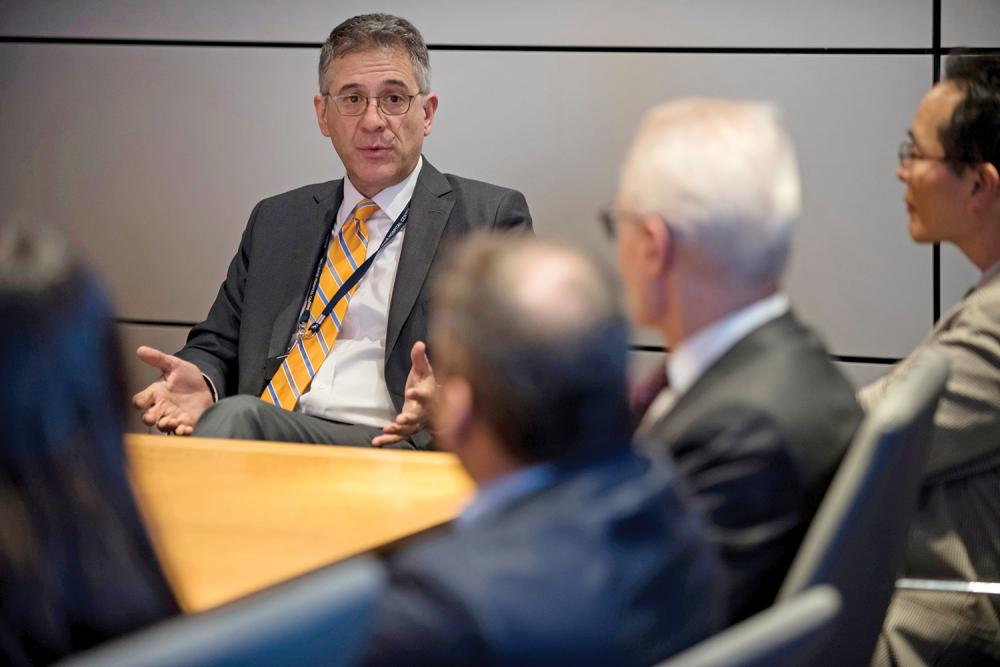The incidence of thyroid cancer in the United States has doubled in the past two decades, yet until recently the standard of care—thyroidectomy, often followed by radioactive iodine—had remained largely unchanged. Now, with advances in genotyping and other diagnostic and prognostic tools, researchers and clinicians are rethinking the way we diagnose and treat thyroid nodules, and patients, in turn, are receiving diagnoses and treatments that are better matched to their disease.
New Insights on Genetic Mutation BRAFV600E
At least half of all thyroid cancers are due to one very nasty genetic mutation in a single nucleotide that causes uncontrolled cell division and tumorigenesis. In fact, the most aggressive cancers have a much higher frequency of this mutation, closer to 70 to 80 percent. The focus of intense study in recent years, this mutation, BRAFV600E, has another serious consequence: it interferes with the unique ability of thyroid tissue to take up iodine, including radioactive iodine, the mainstay for treating diagnosed thyroid tumors in patients who can’t be cured by surgery alone. Papillary thyroid cancers that contain a BRAFV600E mutation often respond poorly to radioactive iodine and frequently recur at a high rate within the first two to three years after treatment.
“For those patients who need it most, radioactive iodine is the least effective,” explains Steven P. Hodak, MD, professor of medicine, director of the Center for Diabetes and Metabolic Health, and chief of endocrinology at Tisch Hospital.
Over the past year, Dr. Hodak’s team has been trying to reverse this effect, exploring the possibility of using drugs already approved for other cancers to pretreat thyroid cancer patients who have clinically aggressive BRAFV600E tumors. The experiments represent NYU Langone’s first foray into translational thyroid cancer research. Evidence shows that even at the initial tumor presentation, overactivation of a main cell-signaling pathway controlled by BRAFV600E causes the de-expression of a membrane protein called the sodium iodide symporter. This transporter acts as the machinery for moving iodine into thyroid cells—including into thyroid cancer cells. For patients with this mutation, a drug that blocks this signaling pathway could increase the tumor’s sensitivity to radioactive iodine therapy.
“But cancer cells are smart,” says Dr. Hodak, “and they have escape pathways to get around the drug blockade.” So the team is targeting two additional molecules: a membrane signaling protein called ERBB3 and another signaling molecule downstream of BRAFV600E known as MEK. In the researchers’ first cell-line experiments, they are using small interfering RNAs to block all three molecules alone and in combination to determine which cocktail induces maximum re-expression of the symporter. If that works, they will use already-approved drugs that inhibit these specific molecules to see if they can get the cancer cells to exhibit the same re-expression. Once this combination therapy is validated in vitro, the team can move directly to testing it in phase II clinical trials.
Other researchers have explored similar approaches for restoring radioactive iodine uptake in advanced widely metastatic, iodine-refractory tumors. However, the application in earlier-stage cancers has not been sufficiently studied, despite the fact that these tumors constitute the vast majority of thyroid cancers.
“If we can prove it, and I believe we will, we really are going to explode the paradigm for how we treat these patients,” says Dr. Hodak. “It will become standard of care to pretreat patients with sensitizing therapy to enhance the radioactive iodine effect, and patients will do much better. We’ll see fewer recurrences and reduce the incidence of life-threatening advanced metastatic cancer down the line.”
Reclassifying Low-Grade Tumors as ‘Not Cancer’ Reduces Overtreatment
On the other end of the spectrum are the least-aggressive tumors, with low-grade, bland mutations that show no signs of invasiveness, a type of cancer called encapsulated follicular variant of papillary thyroid carcinoma. Over the course of a year, using molecular genetic testing, clinical-outcome studies, and evaluation of a large sample set of tumors provided by a number of institutions, an international panel of doctors determined that these tumors are very low-risk in their behavior and shouldn’t be called cancer at all. The word “cancer,” they determined, misrepresents the biological nature of this tumor and often drives doctors to overtreatment, exposing patients to unnecessary risk and expense.
“We wanted to remove the word ‘cancer’ from this tumor’s name because it was being overtreated and in fact it’s not a cancer in the sense that it does not behave invasively,” says Dr. Hodak, who served as one of two endocrinologists on the 31-member panel. The team renamed the tumor “noninvasive follicular thyroid neoplasm with papillary-like nuclear features,” or NIFTP, and established new diagnostic criteria. In April 2017, the World Health Organization codified NIFTP as a diagnosis, a move that will spare more than 45,000 patients worldwide each year from thyroidectomies and a lifetime dependence on medication and regular checkups, along with the psychological burden of a cancer diagnosis.
“We recognize that these are tumors with invasive potential and they need to be discovered and surgically removed, but the goal is to eliminate the overtreatment with excessive surgery or radioactive iodine that would then often follow,” says Dr. Hodak.


